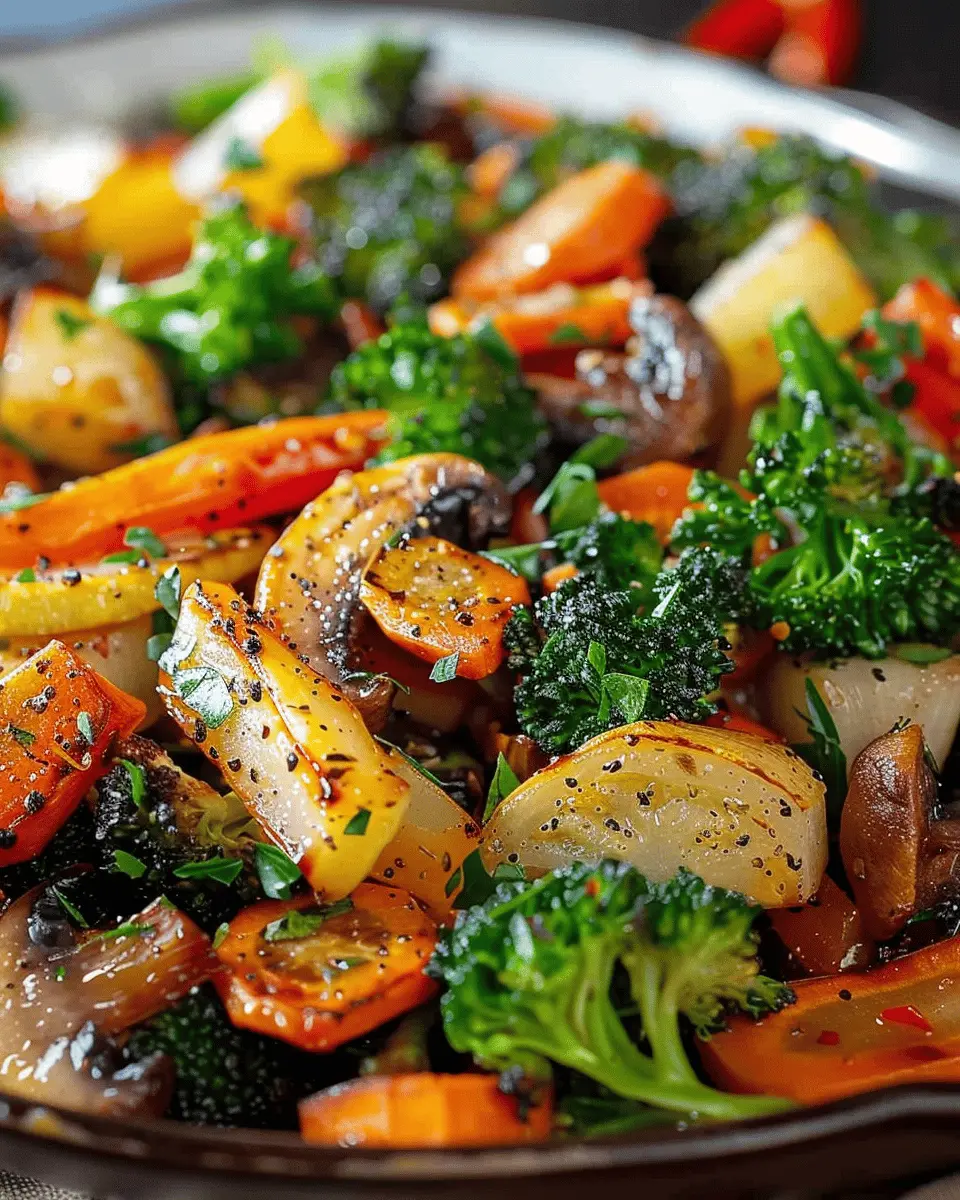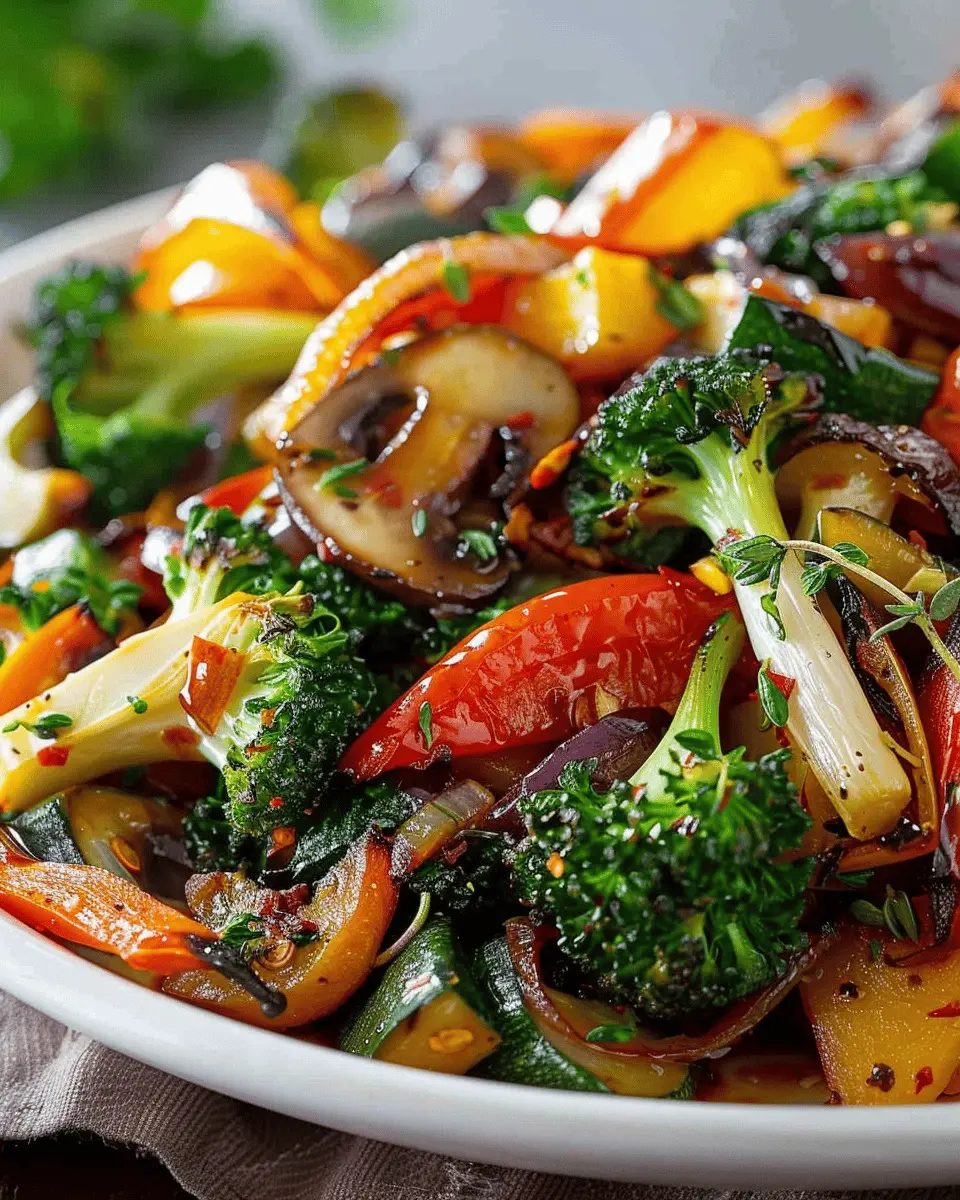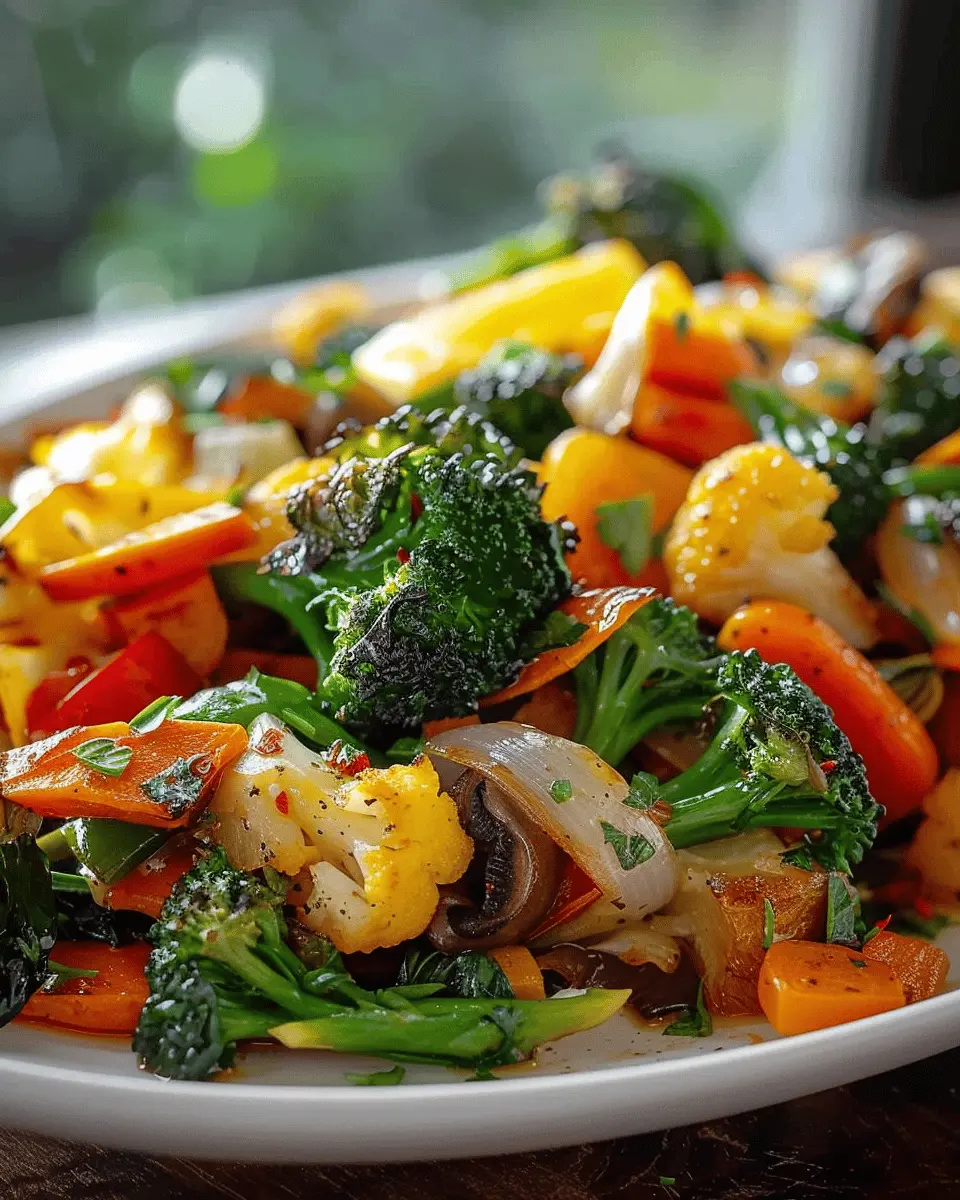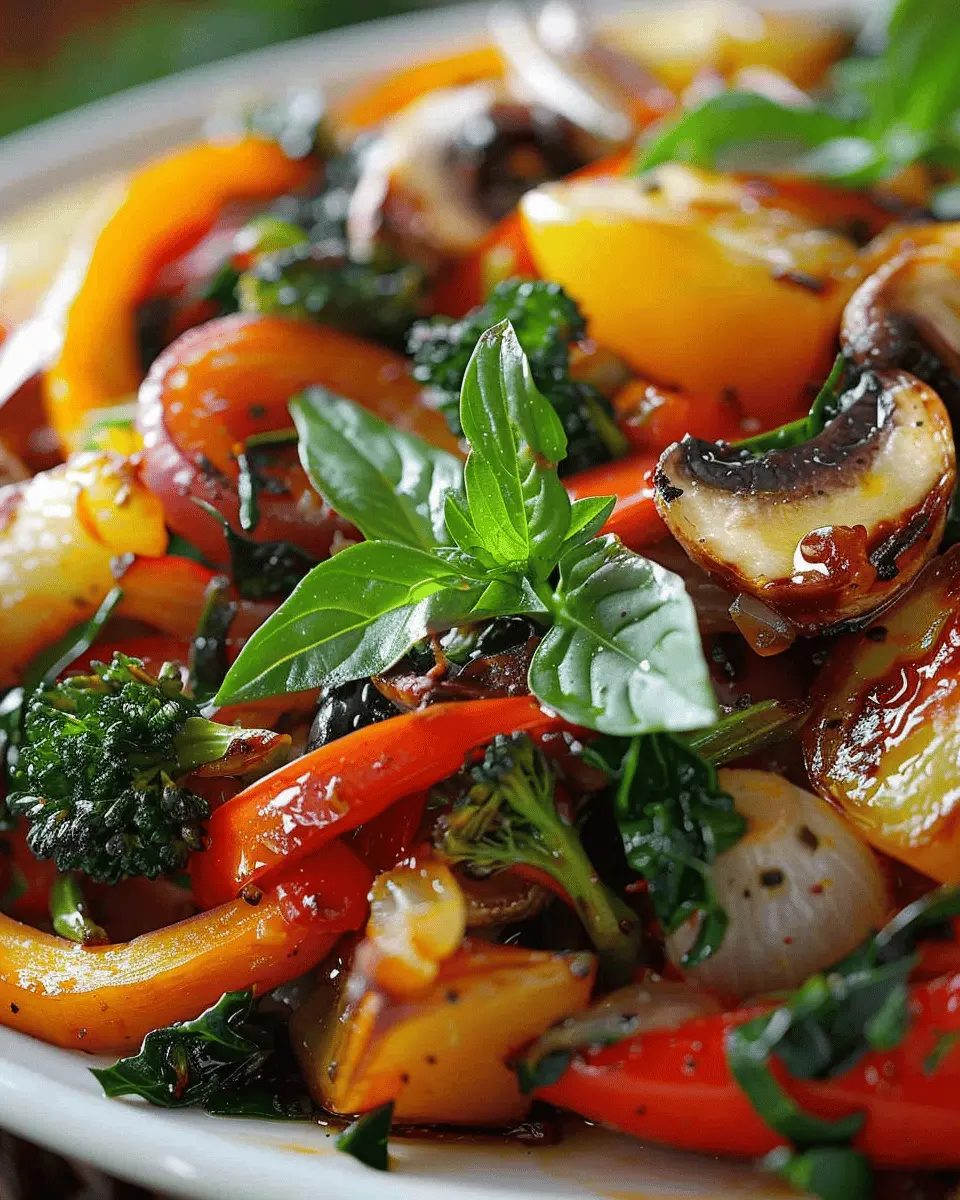Introduction to Healthy Sautéed Vegetables
If you’re a young professional, you likely have a busy lifestyle that leaves little time for elaborate cooking. That’s where healthy sautéed vegetables come in—they’re quick, easy, and versatile, making them the perfect addition to any meal. In just a few minutes, you can whip up a flavorful side dish packed with nutrients that complements a variety of main courses.
Did you know that including more vegetables in your diet can lower your risk of chronic diseases? According to the World Health Organization, fruits and vegetables can reduce heart disease and cancer risks, leading to better overall health. But who has the time to prep and cook a vegetable medley from scratch every night? Thankfully, sautéing is a cooking method that not only retains the vitamins and minerals in your veggies but also enhances their natural flavors without the need for lengthy preparation.
Sautéing vegetables is as simple as putting them in a pan with a splash of olive oil and letting them dance around the heat. You can use whatever veggies you have on hand—bell peppers, zucchini, broccoli, and even leafy greens like spinach or kale work beautifully. The best part? You can customize the seasoning to suit your palate, whether you prefer something spicy with a hint of chili flakes or a more subtle garlic infusion.
Why Sautéed Vegetables are Perfect for Young Professionals
Sautéed vegetables are not just easy to prepare; they are incredibly flexible! Here’s why they fit seamlessly into a busy lifestyle:
- Quick Cook Time: Most vegetables need only 5-10 minutes to cook, making the sautéing process ideal for a post-work meal.
- Minimal Clean-Up: With just a single pan involved, clean-up is a breeze.
- Endless Variety: Mix and match seasonal vegetables to keep your meals interesting and fresh.
Are you feeling inspired? Consider this: What if you could elevate your meal with seasonal, healthy sautéed vegetables as a vibrant side? Pair them with some delicious grilled chicken or seasoned turkey bacon for a complete dinner.
So, why not bring some delicious healthy sautéed vegetables into your regular meal rotation? They’ll not only save you time but also help you maintain a nutritious diet! If you’re eager to dive into a healthy dish tonight, let’s get started with the full recipe below!

Ingredients for Healthy Sautéed Vegetables
Fresh Vegetables: The Star of the Dish
When it comes to healthy sautéed vegetables, choose a vibrant selection that excites your palate. Think crisp bell peppers, vibrant zucchini, earthy mushrooms, and fresh spinach. These not only add color but also deliver essential vitamins and minerals. You can also experiment with seasonal vegetables, such as asparagus in spring or hearty squash in the fall. According to the U.S. Department of Agriculture (USDA), eating a variety of vegetables can help you meet your daily nutrient needs.
Essential Pantry Staples
To bring your sautéed vegetables to life, having a few pantry essentials is key. Here’s what you’ll need:
- Olive oil or avocado oil: Great for a healthy fat source that enhances flavor.
- Garlic and onions: These aromatics form the backbone of delicious dishes, providing depth and richness.
- Herbs and spices: Fresh or dried thyme, basil, and a pinch of salt and pepper can elevate the taste immensely.
- Chicken broth or vegetable broth: A splash can add moisture and an extra layer of flavor without extra calories.
These simple ingredients can transform basic veggies into a delightful side dish, perfect for any meal!
Step-by-Step Preparation of Healthy Sautéed Vegetables
Cooking can feel like a chore at times, but making healthy sautéed vegetables is not only quick and easy; it’s also a delightful way to infuse some vibrant flavors into your meals. Whether you’re looking to complement a protein or simply want a nutritious side dish, sautéed veggies can be a game-changer. Let me guide you through the process, step by step.
Gather Your Ingredients
Before we dive into the cooking process, it’s crucial to gather all your ingredients. This not only streamlines your cooking but also helps you avoid that frantic search for a missing vegetable mid-cook!
For this recipe, you’ll need:
- Fresh vegetables (bell peppers, zucchini, broccoli, carrots, etc.)
- Olive oil or avocado oil
- Garlic and/or onion (for flavor)
- Salt and pepper
- Optional: fresh herbs (like basil or parsley), lemon juice, or spices (like paprika or red pepper flakes) for an extra kick
Pro Tip: Fresh vegetables are your best bet for flavor and nutrition, so consider visiting your local farmer’s market if you can!
Prep Your Vegetables
Once everything is in order, the next step is prepping your vegetables. Rinse them under cold water to remove any dirt and pesticides, then chop them into bite-sized pieces. Uniform size is key here; it ensures even cooking. Here’s a quick guide based on texture:
- Soft vegetables (e.g., zucchini): Chop into smaller pieces.
- Harder vegetables (e.g., carrots): You can slice them a bit thicker as they take longer to cook.
Heat Your Skillet
Now that our veggies are prepped, let’s get the skillet ready. Heat a large non-stick skillet over medium-high heat.
- Add about 2 tablespoons of olive oil once the skillet is hot. Swirl it around to cover the pan evenly.
A hot skillet will sear the vegetables, locking in their flavors and leaving that delicious caramelized effect.
Sauté the Aromatics
Add aromatics like minced garlic or diced onions first. These ingredients not only provide a beautiful foundation of flavor but will also make your kitchen smell divine.
- Sauté for about 1-2 minutes until they soften and become fragrant. Don’t let them burn!
Did you know? Garlic has numerous health benefits, including boosting the immune system and reducing blood pressure?
Add Harder Vegetables
It’s time to layer in the vegetables based on cooking time! Start with the harder vegetables first.
- Add chopped carrots and broccoli, and sauté for about 3-4 minutes, stirring occasionally.
This cooking method allows these tougher veggies to soften while retaining their crunch and nutrients.
Incorporate Softer Vegetables
Once the hard vegetables have begun to soften, it’s time to introduce the softer ones.
- Toss in bell peppers and zucchini. Continue to sauté for another 3-5 minutes.
Remember, the goal here is to achieve tender-crisp vegetables. Overcooking can lead to a mushy texture, which isn’t appetizing!
Season to Perfection
Now comes the fun part—seasoning!
- Sprinkle in salt and pepper to taste, along with any other herbs or spices you’ve chosen. A squeeze of lemon juice can brighten the dish considerably.
Why season as you go? You’ll develop layers of flavor that make your dish not only healthy but utterly delicious!
Toss and Serve
Finally, give everything a good toss to ensure the seasoning is evenly distributed.
- Remove the skillet from the heat, and there you have it—your healthy sautéed vegetables are ready to shine!
Serve them warm as a side to your favorite protein or enjoy them as a stand-alone dish bursting with flavor.
Sautéing vegetables not only enhances their taste but also retains much of their nutritional benefits! For more cooking tips and healthy recipes, check out this resource dedicated to nourishing your body through food. Enjoy your culinary creation!

Variations on Healthy Sautéed Vegetables
Sautéed vegetables can be incredibly versatile. By changing the ingredients and flavor profiles, a simple dish can transform into a culinary adventure. Here are some delightful variations that will keep your meals exciting and nutritious.
Seasonal Vegetable Medley
Embrace the freshness of the season by incorporating vegetables that are at their peak. Think vibrant bell peppers, zucchini, asparagus, and radishes in spring; hearty squash and root vegetables in fall. Try sautéing with:
- Olive oil and minced garlic
- A sprinkle of fresh herbs like thyme or basil
- A squeeze of lemon juice for brightness
This seasonal approach not only boosts flavor but ensures you get the best nutrients! You can learn more about the benefits of eating seasonal produce here.
Asian-Inspired Sautéed Vegetables
Looking to spice things up? Consider making healthy sautéed vegetables with an Asian twist. Combine bok choy, snap peas, and carrots, and sauté them in:
- Sesame oil
- Soy sauce or tamari for a gluten-free option
- Fresh ginger and garlic for a kick
Top it off with sesame seeds or chopped scallions for a delightful crunch. Check out this great resource on Asian cuisines.
Mediterranean Twist
If you crave a taste of the Mediterranean, mix it up with bell peppers, eggplant, and spinach. Sauté in:
- Extra virgin olive oil
- A dash of balsamic vinegar
- Feta cheese crumbles for added creaminess
Add in some olives for saltiness, and you’ve got an easy dish that feels fancy and is packed with flavor. With these variations, your healthy sautéed vegetables will never be boring!
Cooking Tips and Notes for Healthy Sautéed Vegetables
Maximizing Flavor and Nutrition
When it comes to preparing healthy sautéed vegetables, the key lies in balancing flavor and nutrition. Start by selecting fresh, seasonal veggies like bell peppers, zucchini, and broccoli for optimal taste and nutrients. Before cooking, consider soaking them briefly in lemon juice or a splash of vegetable broth. This method not only enhances flavor but also ensures the veggies retain their vibrant colors and nutritional value.
Cooking over medium-high heat is crucial—you want that quick sear! Aim for just 5-7 minutes, stirring frequently, to maximize crispiness while keeping the veggies tender. For added depth, toss in some minced garlic or ginger during the last minute of cooking to release their aromatic oils without losing their health benefits.
Storing Leftovers Effectively
If you happen to have some healthy sautéed vegetables left over, don’t fret! Store them in an airtight container in the fridge for up to three days. Reheat them in a nonstick skillet over low heat to preserve texture—you’ll want to avoid a soggy mess. For longer storage, consider freezing: spread them out on a baking sheet, freeze until solid, and then transfer to a freezer-safe bag. This way, you can enjoy them anytime, without sacrificing quality.
For more tips, check out websites like Healthline for deeper insights into vegetable benefits!

Serving Suggestions for Healthy Sautéed Vegetables
Pairing Ideas for Main Dishes
When it comes to serving healthy sautéed vegetables, the possibilities are endless! These vibrant veggies shine alongside a variety of main dishes, making them an adaptable side that complements many flavors. Consider pairing them with:
- Grilled chicken or turkey for a protein-packed meal.
- Brown rice or quinoa, providing a wholesome base to absorb all those delicious flavors.
- Flaky fish like salmon or tilapia, where the freshness of the vegetables balances the richness of the fish.
What about adding them to a hearty grain bowl topped with your favorite protein? The crunch and colors will not only make it visually appealing but also nutrient-dense.
Creative Ways to Garnish
Garnishing can elevate your dish from simple to sensational! Here are some fun ideas to enhance your healthy sautéed vegetables:
- Fresh herbs: Sprinkle with chopped parsley, basil, or cilantro for a burst of flavor.
- Zest it up: A touch of lemon or lime zest adds a refreshing zing.
- Nuts and seeds: Toasted almonds or sunflower seeds provide a satisfying crunch.
By layering flavors and textures, you’ll create a delightful eating experience. For more inspiration, explore websites like Serious Eats or Food Network for additional ideas on enhancing your dishes!
Time Breakdown for Healthy Sautéed Vegetables
Preparation Time
Getting started with your healthy sautéed vegetables is a breeze! You’ll need about 10 minutes to wash, chop, and prep your veggies. Choose colorful options like bell peppers, zucchini, and broccoli to keep things exciting. If you’re in a rush, consider going for pre-chopped vegetables to save some time.
Cooking Time
Once you’re prepped, the actual cooking takes only 5 to 7 minutes. Heat a bit of olive oil in your skillet, toss in your veggies, and stir frequently. The goal is to keep them crispy and vibrant—no one likes soggy veggies!
Total Time
All in all, this tasty side dish comes together in about 15 to 17 minutes. Perfect for a busy weeknight or a quick addition to your meal prep! For more ideas on quick and healthy cooking, check out sources like Nutrition.gov for tips on veggie choices. Enjoy your flavorful journey!
Nutritional Facts for Healthy Sautéed Vegetables
Caloric Content
When you whip up a batch of healthy sautéed vegetables, you’re treating yourself to a guilt-free side dish! Typically, a one-cup serving contains around 100 calories, making it an excellent option for those mindful of their caloric intake. The beauty of these vegetables is that the calorie count is largely dependent on your choice of veggies and cooking oils.
Key Nutrients per Serving
These vibrant veggies are not just low in calories; they are nutrient powerhouses! In each serving, you’ll find:
- Vitamins: High in Vitamin C and Vitamin K, essential for immune health and blood clotting.
- Minerals: Rich in potassium and magnesium, which support heart health and muscle function.
- Fiber: Each serving provides a healthy dose of dietary fiber, aiding digestion and promoting satiety.
For more about the incredible benefits of vegetables, check out this Nutritional Guide from the USDA! Enjoy your healthy sautéed vegetables knowing they’re not just delicious, but truly good for you. Do you have a favorite vegetable to sauté? Let us know!
FAQs about Healthy Sautéed Vegetables
Can I use frozen vegetables?
Absolutely! Using frozen vegetables can be a quick and convenient option when making healthy sautéed vegetables. They are typically flash-frozen at their peak ripeness, which helps retain nutrients. Just remember to thaw them first, or you might end up with a watery dish. A quick tip: you can drain them in a colander and pat them dry with a paper towel before sautéing to avoid excess moisture.
How do I keep sautéed vegetables crisp?
To achieve that delightful crunch in your healthy sautéed vegetables, several strategies can help:
- Separate cooking: If you’re using a variety of veggies, sauté them in stages according to their cooking times. For instance, start with denser vegetables like carrots and finish with more tender ones like bell peppers.
- High heat: Sauté on medium-high heat, allowing the vegetables to sear quickly rather than steam.
- Don’t overcrowd the pan: If the pan is too crowded, your vegetables will steam instead of sauté. Work in batches if needed.
What are the best oils for sautéing vegetables?
When it comes to sautéing, choosing the right oil can elevate your healthy sautéed vegetables. Here are some worthwhile options:
- Olive oil: Rich in healthy fats and flavor.
- Avocado oil: High smoke point and great for high-heat cooking.
- Coconut oil: Adds a unique taste, particularly in certain cuisines.
Using these oils not only enhances flavor but also provides essential nutrients. For more insights on oils, check out WebMD.
Incorporating these tips will not only make your healthy sautéed vegetables delicious but also a staple in your kitchen!
Conclusion on Healthy Sautéed Vegetables
Recap on the Benefits of Homemade, Healthy Sautéed Vegetables
Cooking with healthy sautéed vegetables is more than just a delightful way to enhance your meals—it’s an investment in your well-being. By preparing these vibrant dishes at home, you control the quality and freshness of your ingredients, making your plate not only visually appealing but packed with essential nutrients.
Research shows that incorporating a variety of vegetables into your diet can significantly reduce the risk of chronic diseases. Plus, sautéing is a quick cooking method that preserves flavors and nutrients while allowing for creativity with spices and herbs. So why not experiment? Try out different combinations to discover your perfect blend! For more inspiration, check out the benefits of a plant-based diet here.
Incorporating healthy sautéed vegetables into your meals can elevate your cooking game—making it both fast and flavorful! Sautéing is not just a technique; it’s a way to embrace a healthier lifestyle that fits seamlessly into your busy schedule. Enjoy each crunch, savor every bite, and feel good about your choices!
PrintHealthy Sautéed Vegetables: Quick, Flavorful & Nutritious Side Dish
A delicious and healthy side dish, sautéed vegetables are quick to prepare and nutritious. Perfect for any meal!
- Prep Time: 10 minutes
- Cook Time: 10 minutes
- Total Time: 20 minutes
- Yield: 4 servings 1x
- Category: Side Dish
- Method: Sautéing
- Cuisine: American
- Diet: Vegetarian
Ingredients
- 2 cups mixed bell peppers
- 1 cup zucchini, sliced
- 1 cup broccoli florets
- 2 tablespoons olive oil
- 1 teaspoon garlic powder
- Salt to taste
- Black pepper to taste
Instructions
- Heat olive oil in a large skillet over medium heat.
- Add the bell peppers and zucchini, and sauté for about 3-4 minutes.
- Add the broccoli florets and season with garlic powder, salt, and pepper.
- Sauté for another 5-7 minutes until vegetables are tender.
- Serve hot as a side dish.
Notes
- For added flavor, consider adding fresh herbs or lemon juice at the end.
Nutrition
- Serving Size: 1 cup
- Calories: 100
- Sugar: 4g
- Sodium: 200mg
- Fat: 7g
- Saturated Fat: 1g
- Unsaturated Fat: 6g
- Trans Fat: 0g
- Carbohydrates: 10g
- Fiber: 3g
- Protein: 3g
- Cholesterol: 0mg
Keywords: Healthy Sautéed Vegetables, Quick Side Dish, Nutritious Vegetables














